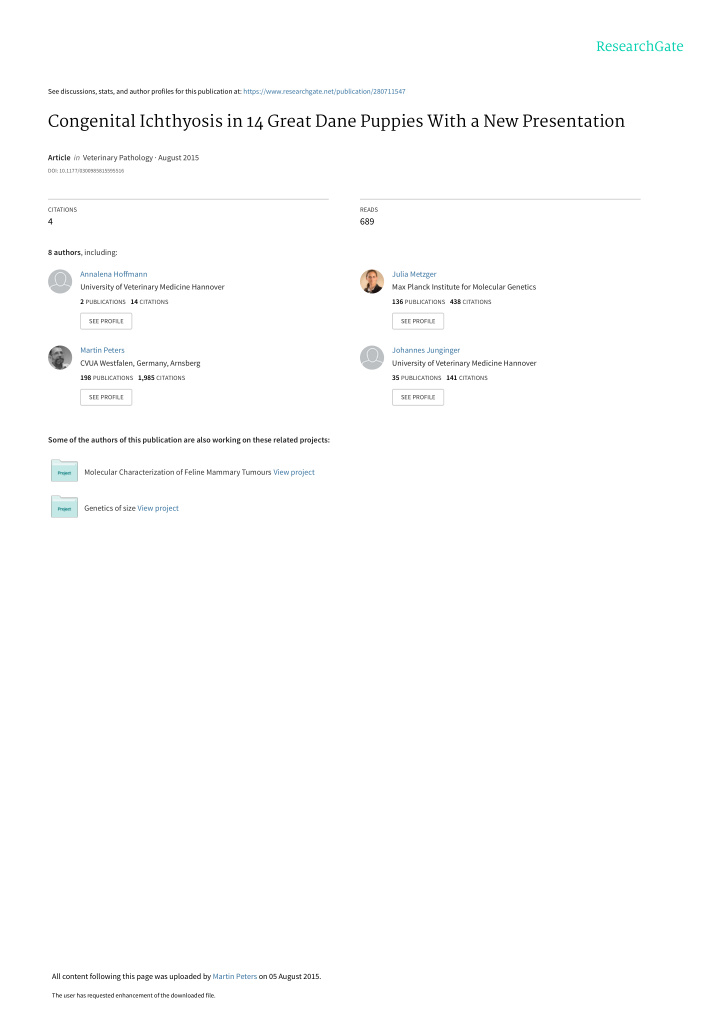



See discussions, stats, and author profiles for this publication at: https://www.researchgate.net/publication/280711547 Congenital Ichthyosis in 14 Great Dane Puppies With a New Presentation Article in Veterinary Pathology · August 2015 DOI: 10.1177/0300985815595516 CITATIONS READS 4 689 8 authors , including: Annalena Hoffmann Julia Metzger University of Veterinary Medicine Hannover Max Planck Institute for Molecular Genetics 2 PUBLICATIONS 14 CITATIONS 136 PUBLICATIONS 438 CITATIONS SEE PROFILE SEE PROFILE Martin Peters Johannes Junginger CVUA Westfalen, Germany, Arnsberg University of Veterinary Medicine Hannover 198 PUBLICATIONS 1,985 CITATIONS 35 PUBLICATIONS 141 CITATIONS SEE PROFILE SEE PROFILE Some of the authors of this publication are also working on these related projects: Molecular Characterization of Feline Mammary Tumours View project Genetics of size View project All content following this page was uploaded by Martin Peters on 05 August 2015. The user has requested enhancement of the downloaded file.
Veterinary Pathology OnlineFirst, published on August 4, 2015 as doi:10.1177/0300985815595516 Original Article Veterinary Pathology 1-7 Congenital Ichthyosis in 14 Great Dane ª The Author(s) 2015 Reprints and permission: sagepub.com/journalsPermissions.nav Puppies With a New Presentation DOI: 10.1177/0300985815595516 vet.sagepub.com A. Hoffmann 1 , J. Metzger 2 , A. Wo ¨hlke 2 , M. Peters 3 , J. Junginger 1 , R. Mischke 4 , O. Distl 2 , and M. Hewicker-Trautwein 1 Abstract The present study describes a generalized congenital skin condition in 14 Great Dane puppies. Macroscopically, all dogs showed generalized gray to yellow scaling and skin wrinkles on the head and all 4 extremities. Skin sections were histologically examined using hematoxylin and eosin, Heidenhain’s Azan, and Sudan red III staining methods and by conducting the alcian blue/periodic acid Schiff (AB/PAS) reaction technique on sections. Furthermore, incubation with hyaluronidase was performed. Skin samples were ultrastructurally analyzed using transmission electron microscopy. All affected Great Dane puppies had epidermal and follicular orthokeratotic hyperkeratosis, enlarged keratohyaline granules, vacuolated keratinocytes, and accumulations of an eosinophilic and alcianophilic, lipid-rich material within dilated hair follicular lumina and the cytoplasm of sebocytes. The macroscopic, histopathologic, and ultrastructural skin changes in all 14 Great Dane puppies indicate a new variant of a primary disorder of cornification with congenital, non-epidermolytic, lamellar ichthyosiform appearance. Keywords canine, Great Dane, congenital, hyperkeratosis, ichthyosis, sebaceous glands Introduction Materials and Methods Ichthyoses are a heterogenous group of rare congenital disor- Animals and Clinical Findings ders of cornification that are characterized by hyperkeratosis Fourteen Great Dane puppies, 6 female and 8 male, aged from a and scales. This condition has been reported in cattle, dogs, few days to 5 weeks and originating from 6 different litters pigs, chickens, laboratory mice, and a llama. 3,11,20 Based on (Table 1) had been submitted for necropsy between 2006 and histologic findings, ichthyoses can be subdivided into epider- 2014 to the Department of Pathology, University of Veterinary molytic and non-epidermolytic forms. In epidermolytic Medicine Hannover (dog Nos. 1–11, 13, and 14) or to the ichthyosis, vacuolization and lysis of keratinocytes together CVUA-Westfalia in Arnsberg (dog No. 12). Dog Nos. 1 through with hypergranulosis and hyperkeratosis occur within the spi- 12, after clinical examination, were euthanized at veterinary nous and granular cell layers. 7,22 Non-epidermolytic ichthyosis practices with the consent of the owners. Two puppies (dog Nos. is mainly characterized by marked, lamellar, orthokeratotic 13and 14), which were referred to the Small Animal Clinic, Uni- hyperkeratosis and mild acanthosis. 19 Ichthyosiform disorders versity of Veterinary Medicine Hannover in 2014, were exam- in dogs have strong breed predilections although they can occur ined clinically by 1 of the investigators (R.M.) and were in mixed-breed dogs as well. 1,10,14,19,21 Syndromic ichthyoses, euthanized with the consent of the owners. All animals had characterized by extracutaneous lesions, have been described in dogs, such as in the Cavalier King Charles spaniel with keratoconjunctivitis. 4,15,16 Congenital, non-epidermolytic forms of ichthyosis with clinical and histomorphological fea- 1 Department of Pathology, University of Veterinary Medicine Hannover, Hannover, Germany tures resembling autosomal recessive congenital ichthyosis in 2 Institute for Animal Breeding and Genetics, University of Veterinary Medicine humans (ARCI) have been described in several purebred dog Hannover, Germany breeds, such as Golden Retriever, American Bulldog, and Jack 3 Chemical and Veterinary Investigation Office (CVUA) Westfalia, Arnsberg, Russell Terrier. 11,12,14,20,21 Germany The aim of this study was to describe the macroscopic, his- 4 Small Animal Clinic, University of Veterinary Medicine Hannover, Hannover, Germany topathologic, and ultrastructural features of a new variant of a non-epidermolytic, congenital ichthyosis observed in Great Corresponding Author: Dane puppies associated with accumulations of an alcianophi- Marion Hewicker-Trautwein, Department of Pathology, University of lic and lipid-rich material within sebaceous glands and dilated Veterinary Medicine Hannover, Bu ¨nteweg 17, D-30559 Hannover, Germany. hair follicle lumina. Email: marion.hewicker-trautwein@tiho-hannover.de Downloaded from vet.sagepub.com by guest on August 5, 2015
Recommend
More recommend